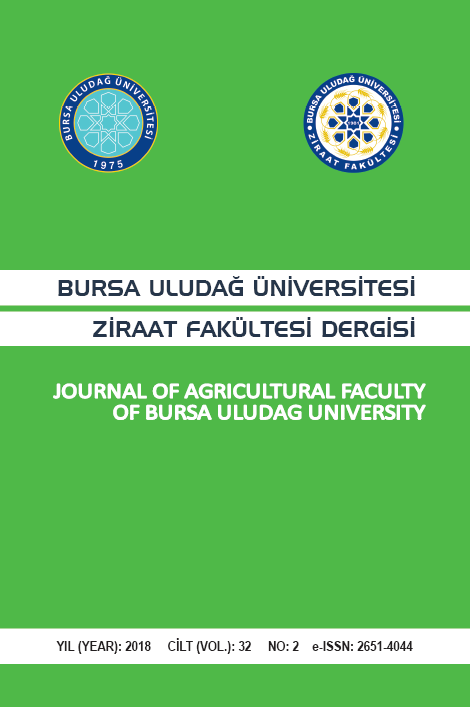Hayward ve Matua Kivi Çeşitlerinde Mikro Çoğaltım
Actinidia deliciosa, mikro çoğaltım, eksplant tipi, besin ortamları, IBA
Hayward ve Matua Kivi Çeşitlerinde Mikro Çoğaltım
-,
___
- Barbieri, C. and S. Morini. 1988. Shoot Regeneration from Callus Cultures of Actinidia chinensis (cv. Hayward). Acta Horticulturae, 227: 470-472.
- Canhoto, J.M. and G.S. Cruz. 1989. In Vitro Multiplication of Actinidia chinensis Planch. by Culture of Young Leaves. Boletim da Sociedade Broteriana, 60: 239-252.
- Ding, S.L., X.Z. Zhu and H.M. Yu. 1997. Kiwifruit Tissue Culture. China Fruits, 2: 27-29.
- Kamenicka, A. and M. Rypak. 1990. The Regeneration of Actinidia chinensis Planch. Cultured In Vitro. Horticultural Abstracts, 60 (6): 4156.
- Kumar, S and D.R. Sharma. 2002. In Vitro Propagation of kiwifruit. Journal of Horticultural Science and Biotechnology, 77 (5): 503-508.
- Kumar, S., C. Subodh, H. Gupta and D.R. Sharma. 1998. Micropropagation of Actinidia deliciosa from Axillary Buds. Phytomorphology, 48 (3): 303-307.
- Kyte, K. and J. Kleyn. 1996. Plants from Test Tubes. Timber Press, Portland, Oregon, USA. 240 pp.
- Mansuroğlu, S. ve E. Gürel. 2001. Mikroçoğaltım. “Bitki Biyoteknolojisi I – Doku Kültürü ve Uygulamaları” (Editörler: M. Babaoğlu, E. Gürel ve S. Özcan), Selçuk Üniversitesi Basımevi, Konya. s. 262-281.
- Marino, G. and G. Bertazza. 1990. Micropropagation of Actinidia deliciosa cvs ‘Hayward’ and ‘Tomuri’. Scientia Horticulturae, 45: 65-74.
- Moncalean, P., M.J. Canal, I. Feito, A. Rodriguez and B. Fernandez. 1999. Cytokinins and Mineral Nutrition in Actinidia deliciosa (Kiwi) Shoots Cultured In Vitro. Journal of Plant Physiology, 155 (4/5): 606-612.
- Monette, P.L. 1986. Micropropagation of Kiwifruit Using Non-Axenic Shoot Tips. Plant Cell Tissue Organ Culture, 6: 73-82.
- Monette, P.L. 1987. Organogenesis and Plantlet Regeneration Following In Vitro Cold Storage of Kiwifruit Shoot Tip Cultures. Scientia Horticulturae, 31: 101-106.
- Nachtigal, J.C., A.G.D. Zecca, S.L.B. Figueiredo and G.R.d.L. Fortes. 1995. Effect of Benzylaminopurine (BAP) on the In Vitro Multiplication of Kiwifruit (Actinidia deliciosa). Ciencia Rural, 25 (1): 23-26.
- Nasib, A., H. Ali and S. Khan. 2008. An Optimixed and Improved Method for the In Vitro Propagation of Kiwifruit (Actinidia deliciosa) Using Coconut Water. Pakistan Journal of Botany, 40 (6): 2255-2360.
- Pedroso, M.C., M.M. Oliveira and M.S.S. Pais. 1992. Micropropagation and Simultaneous Rooting of Actinidia deliciosa var. deliciosa ‘Hayward’. HortScience, 27 (5): 443- 445.
- Prado M. J., M. V. Gonzalez, S. Romo and M. T. Herrera. 2007. Adventitious plant regeneration on leaf explants from adult male kiwifruit and AFLP analysis of genetic variation. Plant Cell, Tissue and Organ Culuret 88 (1):1–10.
- Rugini, E. and P. Gutierrez-Pesce, 2003. Micropropagation of kiwifruit (Actinidia ssp). In: Jain, S.M. and K. Ishii (eds.), Micropropagation of Woody Trees and Fruits, pp: 647– 69. Kluwer Academic Publishers, Netherlands.
- Sammarcelli, F. and J.M. Legave. 1990. In Vitro Multiplication by Neoformation in Actinidia deliciosa, Cultivar Hayward. Fruits, 45 (4): 393-401.
- Sotiropoulos, T.E., K.N. Dimassi and V. Tsirakoglou. 2006. Effect of boron and methionine on growth and ion content in kiwifruit shoots cultured in vitro. 50 (2): 300-302.
- Souad, B., S.M. Lionakis and D. Gerasopoulos. 1998. Effects of Explant Type on Proliferation and Rooting of Kiwi In Vitro. Advances in Horticultural Science, 12 (3): 123-126.
- Spasenoski, M. and M. Neskovic. 1987. In Vitro Vegetative Propagation of Actinidia chinensis Planch. from Juvenile and Adult Plant Segments. Horticultural Abstracts, 57 (11): 8334.
- Tanimoto, G. 1994. Propagation. “In: Kiwifruit Growing and Handling (Eds., J.K. Hasey, R.S. Johnson, J.A. Grant and W.O. Reil)”. University of California, Division of Agriculture and Natural Resources, Publication 3344, 21-24.
- Tezcan, H., N. Sivritepe ve Y. Tuğ. 2001. Kivinin In Vitro Çoğaltımında Fungal Bulaşmaların Önlenmesi Üzerine Bazı Fungusitlerin Etkileri. Türkiye IX. Fitopatoloji Kongresi, 3-8 Eylül 2001, Tekirdağ. Bildiriler Kitabı, s. 649-655.
- Wang, D., Y.L. Gui and J.S. Sun. 1988. Tissue Culture of Fruit Crops in China. HortScience, 23 (6): 962-965.
- Wessels, E., D.D. Nel and D.F.A. von Staden. 1984. In Vitro propagation of Actinidia chinensis Pl. Cultivar Hayward. Deciduous Fruit Grower 34 (12): 453-457.
- Wiyaporn S., S. Subhadrabandhu and O. Sahavacharin. 1990. In Vitro Vegetative Multiplication of Kiwi Plant. Acta Horticulturae, 279: 447-459.
- Xiao, X.G., A.M. Hirsch and D. Fortune. 1991. Regeneration of Kiwifruit (Actinidia deliciosa Cultivar Hayward) from Young Leaves. Fruits (Paris), 46 (1): 57-66.
- Yayın Aralığı: Yılda 2 Sayı
- Başlangıç: 1982
- Yayıncı: Bursa Uludağ Üniversitesi
H. Özkan Sivritepe, Bülent Şentürk
Organik Süt Sığırcılığı ve Refah
Nurcan Karslıoğlu Kara, Mehmet Koyuncu
Effects of Different Salt Concentrations (NaCl) on Germination of Some Spinach Cultivars
Ahmet Turhan, Hayrettin Kuşçu, Vedat Şeniz
Pyemotidae (Acari: Heterostigmata) Familyasının Tanımı ve Biyolojisi
Begül Güldali, Sultan Çobanoğlu
Doğal Bir Antimikrobiyel: Oleuropein
Sütün Raf Ömrünün Uzatılmasında Alternatif Yöntemler
Elektronik Burun Sistemlerinin Tasarım İlkeleri
Ünal Kızıl, Levent Genç, Melis Saçan
Çiğdem DEMİRTAŞ, Ali Osman DEMİR
Hayward ve Matua Kivi Çeşitlerinde Mikro Çoğaltım
Farklı Bitki Sıklıkları ve Azot Dozlarının Silajlık Mısırın Stoma Özellikleri Üzerine Etkileri
